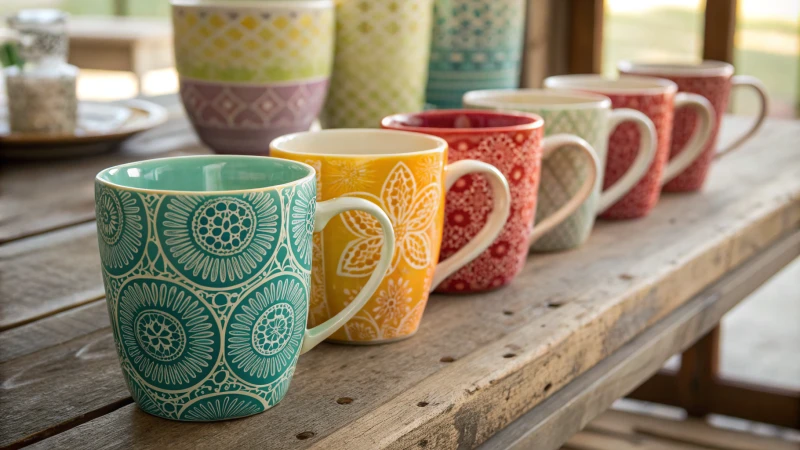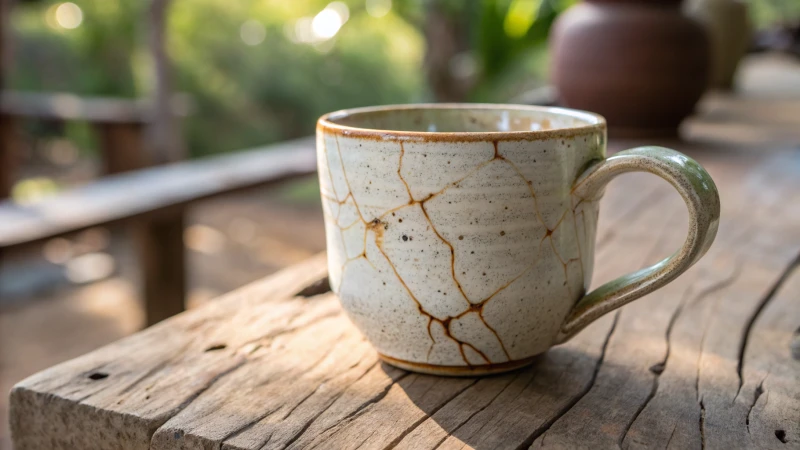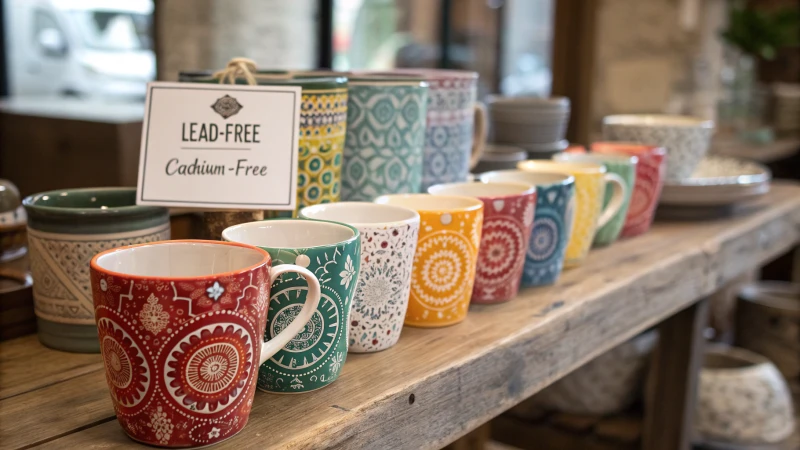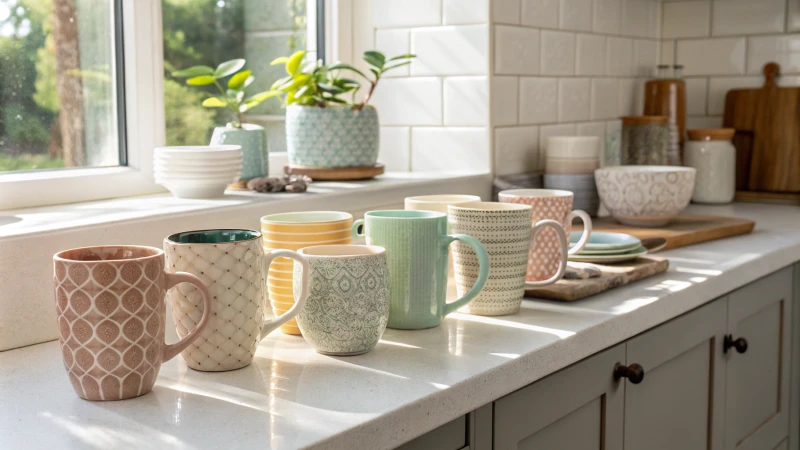
Ceramic mugs might appear to be the ideal option. However, do they have unseen disadvantages that we usually ignore?
Ceramic mugs look very beautiful and come in many designs. However, they have some big drawbacks. These include being fragile and breaking easily. They also do not keep drinks hot for long. Another problem is the risk of heavy metal leaching, which may be harmful. It’s helpful to know these issues when choosing the right mug.
When I first used ceramic mugs, their charm and variety captivated me. But soon, I learned they are not as flawless as they appear. I dropped one of my favorite mugs and it broke into pieces. That moment really broke my heart! Ceramic mugs are very fragile. They easily break. Moreover, they don’t keep drinks hot for long. My morning coffee becomes cold too quickly. In addition, some mugs might release heavy metals if not crafted correctly. Knowing these problems is really important. It helps choose safe options wisely.
Ceramic mugs are more fragile than glass mugs.True
Ceramic mugs can break easily upon impact, making them less durable than glass options.
Ceramic mugs retain heat better than stainless steel mugs.False
Ceramic mugs generally have poor heat retention compared to stainless steel, which keeps beverages hot longer.
What Makes Ceramic Mugs Fragile?
Ceramic mugs are charming. However, they are fragile and pose big challenges for daily use. What causes this delicacy in mugs?
Ceramic mugs break easily because of their material and weight. Glaze imperfections also add to their fragility. Bacteria may grow on them. Sometimes, they contain harmful heavy metals. Knowing these details helps. These facts are important for choosing and using ceramic products smartly.

Understanding Fragility of Ceramic Mugs
Ceramic mugs are often perceived as elegant and aesthetically pleasing, but their fragility can be a significant drawback.
-
Material Composition: Ceramic mugs are primarily made from clay that is fired at high temperatures. This process creates a hard surface, but it also makes the material more susceptible to cracking under stress. For instance, when exposed to sudden temperature changes, the inner structure may not handle the thermal shock well, leading to breakage. I once put a cold mug in the microwave, forgetting it was still hot from my last coffee. The quick temperature change caused a tiny crack. Learn more about thermal shock1.
-
Weight and Thickness: The weight of a ceramic mug can impact its durability. Thicker walls may provide more strength, but they can still break upon impact. In contrast, lighter mugs are easier to carry but are often less durable. A comparison of weight versus thickness can illustrate this point:
Mug Type Average Weight (g) Wall Thickness (mm) Durability Score Standard Ceramic 350 5 6/10 Bone China 250 3 7/10 Stoneware 400 6 8/10 -
Glaze Imperfections: The glaze applied to ceramic mugs can also contribute to fragility. If the glaze is not fully processed, moisture can seep into the ceramic material, leading to odors and structural weaknesses over time. Learning about proper glazing techniques reminded me of neglecting to wash my favorite mug correctly; it ended up with a strange smell that never went away! Explore glazing techniques2.
-
Bacterial Contamination: Small cracks can develop during normal use, which may not be visible to the naked eye. These tiny fissures can harbor bacteria if not cleaned properly. It’s vital to ensure thorough cleaning and disinfecting of ceramic mugs to prevent health risks associated with bacterial growth. I now use a dedicated brush just for cleaning my ceramic mugs after reading about this issue! Read about bacteria in ceramics3.
-
Heavy Metal Concerns: Lastly, the presence of heavy metals in glazes can pose a risk, especially if they are not manufactured under strict guidelines. Consuming beverages from contaminated mugs over time could lead to health issues; hence choosing quality ceramics from reputable manufacturers is essential for safety. Find out about safe ceramic practices4.
Each of these factors contributes to the fragility of ceramic mugs, making them beautiful yet delicate items that require careful handling and maintenance.
Ceramic mugs are prone to cracking from thermal shock.True
Rapid temperature changes can cause ceramic mugs to crack due to their material structure, making them sensitive to thermal shock.
Heavier ceramic mugs are always more durable than lighter ones.False
While heavier mugs may seem stronger, durability also depends on wall thickness and material, not just weight alone.
How Do Ceramic Mugs Compare in Heat Retention?
Ever wondered why your coffee cools so fast in a ceramic mug? I really have. This curiosity led me to think about the science of heat retention in these lovely cups. Let’s discover this together!
Ceramic mugs cool drinks faster than metal or double-walled glass mugs. The porous material and design really cause this. They usually keep heat for about 20 minutes. This short time means they are not great for staying warm for long. Ceramic mugs are less ideal for prolonged warmth.

Understanding Heat Retention in Ceramic Mugs
Ceramic mugs often charm with their beautiful designs. They can brighten any kitchen with their looks. However, they do not keep drinks hot for long. This issue relates to how ceramic interacts with heat.
-
Material Properties: Ceramic is porous. It absorbs and releases heat quickly, unlike metals. I remember holding my favorite ceramic mug on a cold morning. It was full of hot chocolate, but it became lukewarm in minutes. Ceramics tend to lose heat fast—very fast compared to metal mugs.
-
Thickness and Design: Mug thickness influences heat retention. Standard ceramic mugs are around 5mm thick, while double-walled ones measure about 10mm. Thicker mugs might weigh more but keep drinks warm longer.
| Mug Type | Average Thickness (mm) | Heat Retention (minutes) |
|---|---|---|
| Standard Ceramic | 5 | 20 |
| Double-Walled | 10 | 40 |
| Stainless Steel | 1-2 | 60+ |
Comparison with Other Materials
Different mug types offer unique benefits. Each has pros and cons:
- Metal Mugs: Metal mugs excel in heat retention. During camping trips, I noticed my coffee stayed hot for hours. Metal mugs prove great for keeping drinks warm.
- Glass Mugs: Glass mugs look elegant. They shine with colorful drinks inside. Yet, they insulate poorly compared to ceramic or metal; drinks cool faster in glass mugs.
Material affects drink temperature over time. My tea in a ceramic mug cools quickly, which changes the flavor and aroma—really, it does.
Impact of Glaze and Design on Heat Retention
Glaze on ceramic mugs influences heat behavior. Some glazes slow heat transfer; others do not perform well. Design is crucial too:
- Open vs. Closed Designs: Wider mugs let heat escape quickly while narrower openings keep drinks warmer. For longer warmth, pick a smaller opening.
- Color and Finish: Darker colors may absorb more heat but release it faster due to thermal conductivity differences. I choose colors based on mood, but this is important too.
Summary of Considerations
Ceramic mugs, while charming, fail to keep beverages hot as well as other materials do. Choosing the right mug depends on what matters most—looks or practicality.
Explore different mugs and their benefits further by checking out this detailed comparison5. Whether enjoying coffee cozily or savoring tea, finding the right mug enhances the experience.
Ceramic mugs lose heat faster than stainless steel mugs.True
Due to their porous nature, ceramic mugs cool beverages quicker compared to stainless steel, which retains heat effectively.
Thicker ceramic mugs retain heat better than thinner ones.True
In general, thicker ceramic mugs provide improved heat retention due to increased insulation, despite being heavier.
Are There Safety Concerns with Heavy Metals in Ceramic Mugs?
I have enjoyed sipping coffee from my favorite ceramic mug for years. I often wonder if there are hidden dangers in those beautiful designs. Heavy metals like lead and cadmium in ceramic mugs may be a concern. Let’s explore if these worries are really justified.
Safety concerns exist about heavy metals in ceramic mugs. Unregulated manufacturing might cause toxic metals to seep into drinks. Acidic beverages risk this problem more. Certified products should be chosen. It is very important.

Learning About Heavy Metals in Ceramic Mugs
Heavy metals like lead and cadmium sometimes enter the glazes on ceramic mugs. The thought of these toxic substances mixing with my coffee or tea was scary. These metals can be dangerous if the mugs are not produced with strict safety measures. Acidic drinks like citrus water or coffee increase the chance of these metals dissolving.
A study surprised me by showing that some ceramic mugs released lead when filled with coffee. It reminded me of the need to understand how our favorite drinkware is made.
Safety Standards and Rules
It is comforting to know that ceramic makers often follow strict rules to lower the risk of heavy metal contamination. In the U.S., the FDA controls the safety of ceramic dishes, ensuring that levels of lead and cadmium remain below safe limits. However, many imported products might not meet these standards.
| Country | Regulation Authority | Maximum Lead Level (ppm) | Maximum Cadmium Level (ppm) |
|---|---|---|---|
| USA | FDA | 100 | 75 |
| EU | EEC | 0.1 | 0.1 |
| China | GB Standards | 0.5 | 0.5 |
Finding Safe Ceramic Mugs
Not all ceramic mugs are safe. I found some helpful tips:
- Look for Certification Marks: Check for labels from trusted safety organizations; they offer assurance.
- Investigate the Manufacturer: Understand their production methods and quality control; transparency is important.
- Choose Newer Products: Old ceramics might use materials that do not meet today’s safety standards, raising the risk of exposure.
Dangers of Damaged Ceramic Mugs
Using chipped or cracked ceramic mugs increases the risk of heavy metal leaching. Cracks can turn into bacteria breeding grounds if not cleaned well. This is not something you want in your drink. Damaged glaze may let liquids interact with the base material, increasing toxic exposure.
Check your ceramic mugs regularly for damage; it is really worth it for your health.
Final Thoughts on Ceramic Mug Safety
I love my ceramic mugs for their charm and beauty. However, staying aware of heavy metals is vital for safe beverage enjoyment. Knowing potential hazards helps me choose drinkware better. Trust reputable makers and watch for wear and tear on ceramic items.
For more on safe ceramic products, consider exploring ceramic safety guidelines6 or how to choose safe dinnerware7. Health should always come first, even with a simple cup of coffee.
Ceramic mugs can leach heavy metals into beverages.True
Certain ceramic mugs may release lead and cadmium, especially when used with acidic drinks. This poses health risks to consumers.
All ceramic mugs meet FDA safety standards.False
Not all ceramic mugs comply with FDA regulations; many imported products may not meet these safety standards, increasing contamination risks.
What Maintenance Challenges Come with Using Ceramic Mugs?
Ceramic mugs probably have a special place in your heart. These mugs are not just cups for your favorite drinks. They remind you of cozy mornings and moments you cherish. However, they come with their own maintenance challenges. I have learned to handle these challenges over the years. They really require care.
Taking care of ceramic mugs includes dealing with challenges. Ceramic mugs are fragile. They might break easily. They may not keep drinks hot for a long time. These mugs are often heavy. Some might even release harmful metals. Cracks can lead to bacteria growing. Proper care reduces these risks. Regular cleaning helps a lot.

Fragility and Care
Ceramic mugs are lovely and useful, but they need some care to stay nice and useful. I remember dropping my favorite mug. My heart sank as it broke on the floor. This showed me how delicate these pretty items are. It is really important to handle them gently. Incorporating protective storage solutions8 can help maintain their condition. I often wash and store them with great caution, using special storage like padded shelves and mug holders to keep my favorite ones safe.
| Type of Mug | Weight (grams) | Pros | Cons |
|---|---|---|---|
| Ceramic | 300-500 | Aesthetic, Durable | Heavy, Fragile |
| Plastic | 100-200 | Lightweight, Durable | Less aesthetic |
| Glass | 200-400 | Elegant, Microwave Safe | Fragile |
Heat Preservation Issues
I learned hard that ceramic mugs don’t keep drinks hot for long. My tea cools down faster than I prefer. Now, I pick mugs with thicker walls for better heat retention because this small change lets me enjoy my drink without needing to warm it again. Unlike insulated mugs, they can cause beverages to cool quickly when considering the type of drink9 served.
Weight Considerations
Ceramic mugs can be really heavy! Some are so heavy that my arm feels like it might fall off. For people who take coffee on the go, try lighter choices that still look ceramic but not be bulky. It’s about finding the best fit for your lifestyle while looking for lighter alternatives10.
Heavy Metal Release Risks
Heavy metals worry me. Some mugs might leak lead or cadmium if not properly made. When considering safe ceramic options11, I always choose mugs from trusted makers and check their safety certifications because health is really too important to risk!
Bacterial Contamination from Cracks
A tiny crack in a mug seemed harmless, but it was a mistake! It became a home for bacteria because I did not clean it well. Regular cleaning and using high-temperature water can help mitigate this risk now that I regularly check my mugs and use very hot water for cleaning.
Odor Retention from Incomplete Glazing
Flavored teas are a favorite of mine, but bad glazing keeps odors; my mug sometimes smells like old chamomile! To avoid this issue, I choose fully glazed mugs and occasionally use baking soda cleaning techniques12 to keep them fresh.
Ceramic mugs are more fragile than plastic mugs.True
Ceramic mugs can easily chip or crack, making them less durable than plastic options, which are designed to withstand drops and impacts.
Ceramic mugs retain heat better than insulated mugs.False
Insulated mugs are specifically designed to retain heat effectively, while ceramic mugs tend to allow beverages to cool quickly due to their material properties.
Conclusion
Ceramic mugs are aesthetically pleasing but fragile, with poor heat retention and potential heavy metal leaching, necessitating careful handling and maintenance.
-
Discover the science behind ceramic mug fragility and how to choose durable options for your needs. ↩
-
Learn more about the best practices for maintaining ceramic mugs to prevent damage. ↩
-
Understand how glaze imperfections can affect the durability of your favorite ceramic mugs. ↩
-
Explore the differences in durability among various types of ceramic and other materials. ↩
-
Explore various mug types and their impact on heat retention. This could guide your next purchase for optimal beverage enjoyment. ↩
-
Discover essential information on identifying safe ceramic mugs and protecting your health from heavy metal exposure. ↩
-
Learn how to safely enjoy your favorite beverages from ceramic mugs by understanding potential risks. ↩
-
Explore this link to find practical tips on maintaining ceramic mugs to prolong their lifespan and ensure safety. ↩
-
Discover safe ceramic mug options that comply with health standards to avoid heavy metal risks. ↩
-
Learn about cleaning techniques that prevent bacterial contamination in ceramic mugs and maintain hygiene. ↩
-
Find out about the best practices for choosing and caring for fully glazed ceramic mugs to prevent odor retention. ↩
-
Uncover the latest advancements in ceramic mug manufacturing that enhance durability and safety. ↩